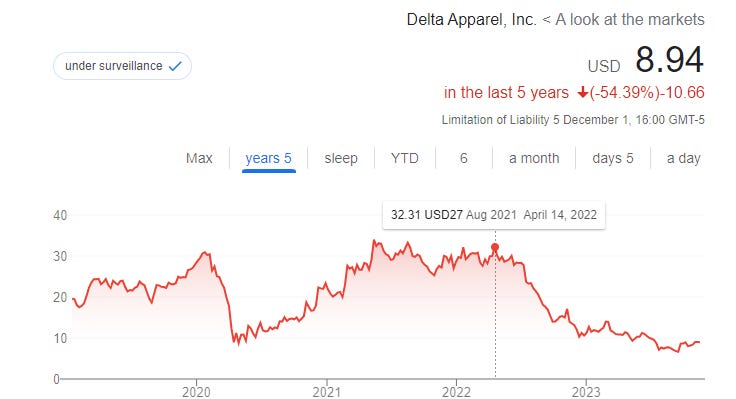December 10th update: A brief section has been added regarding the Q4 earnings call.
Delta Apparel’s (DLA) earnings were negatively affected in the past year due to poor inventory management coupled with macro headwinds and over leverage leading to a sharp decline in its stock price.
We believe Delta's earning power was not impaired in the long term, while the stock price crashed 75%. The current valuation offers a significant margin of safety, with a conservative sum-of-the-parts estimate indicating 3X potential upside from the current price.
Business Overview
Delta Apparel is a vertically integrated, micro-cap apparel company. They report under two segments: Delta Group and Salt Life
Delta Group Segment (83% of revenues)
Delta activewear (~63% of revenues) – supplier of activewear apparel to global brands, retail, and wholesale markets offering a broad portfolio of apparel and accessories.
This is a stable business with little to no growth and lower margins.DTG2Go (~20% of revenues) - on-demand digital print and fulfillment, providing immediate access to their network of facilities for retailers and brands. They deliver digitally printed apparel directly to consumers worldwide within 24 to 48 hours.
DTG2Go is one of Delta’s growth drivers, with sales growing at a CAGR of 24% since 2013.
This is a growing market (12.5% expected CAGR until 2030) and Delta has a first-mover advantage as it is the largest digital direct-to-garment printer in the world outside of Amazon.
Salt Life Group Segment (17% of revenues)
Salt Life is a lifestyle brand that offers a wide range of products, including cotton graphic tees, performance apparel, swimwear, board shorts, sunglasses, bags, and accessories. With 27 retail stores along the U.S. coastline and partnerships with various retail outlets.
This segment stands out as a promising growth driver with double-digit operating margins, and the management is strategically using capex to aggressively expand new stores within Salt Life. Sales grew 22% YOY.
Temporary Impairment - And Market Over-Reaction
In 2021 the industry experienced high demand fueled by the COVID stimulus, and Delta like many others over-stocked on inventory and over-leveraged at exactly the worst time.
Unfortunately for Delta, this coincided with a 10-year peak in cotton prices and the start of a Fed rate hike cycle that would slightly curb demand and raise the cost of capital.
Cotton price chart
Timeline of events
As the global economy emerged from COVID-19, there was a rising demand for apparel products. Delta, along with many other players in the apparel industry, over-stocked on inventory, anticipating sustained high demand.
In 2023, demand started to decrease due to rising interest expenses, leading to a downturn in consumer demand. Consequently, the apparel industry faced the challenge of high inventory levels.
The main raw material utilized in manufacturing apparel products is cotton. During a five-month period, the price of cotton surged by nearly 50%, peaking in April 2022.
Delta found itself with elevated levels of high-price inventory. Delta customers (the majority are retailers) over-stocked as well, and the previous high demand was not sustained.
With less demand, Delta was unable to pass on the increased costs, resulting in recorded losses for that inventory.As a consequence, Delta reported losses in the fiscal year 2023 quarters due to declining revenues, increased interest expenses (5.3% → 7.8%), and a significantly reduced gross margin (25.4% → 13.1%) due to high input costs.
Robert W. Humphreys, the CEO, discussed the inventory situation in the Q1 23 call:
“In Activewear (inventory) I believe we were up about 30%”
“… from the prior-year level of units. Which, again, is daunting, and I'm not really comparing this to other companies we compete with, but just other people in the apparel business that I see, I'd say we're on the low side of average in unit growth in inventory, which is...”
“Now, you think about the sophistications we all thought we had, I don't know how, as an industry, we were so wrong in so many places, and so many people were hoarding inventory or buying more than they needed. Then all of a sudden, the merry-go-round stopped, and everybody had too much inventory at every step.”
We are confident that the challenges are temporary
Consumer demand is expected to return to normal.
Following the cotton price peak, cotton prices have already decreased to $0.75 by October 2022. Consequently, the company is presently manufacturing apparel with lower input costs. As these products enter the market, the company anticipates a return to its original profit margins, considering the use of the FIFO inventory accounting method.
The management is focused on deleveraging which will decrease the interest expense.
Catalyst
De-stocking high-cost inventory and de-levering
During the Q1 23 call, the CEO mentioned that the company anticipates completing the selling of high-cost inventory and returning to the normalized gross margin by Q4 23:
“We see our gross margins improving sequentially by quarter throughout the fiscal year. Based on our current outlook, we would be back to a normalized, or more normalized, gross margin by the time we got to our fourth quarter. We see inventories going down sequentially, both from a unit standpoint and from a valuation standpoint as we go through the quarters.”
Going over the inventory changes during the periods with high cotton prices and comparing it with the cost of goods sold since the gross margin reduction reveals that the high-cost inventory should be cleared by Q2 24 at most.
As they reduce the inventory the management is using the cash flow to pay down debt. This should improve their earnings as they pay close to 8% on their debt.
As the main business returns to normal margins and and deleverage, it will return to normalized earnings and rerate closer to its average past multiples.
Selling Salt Life
Salt Life's earnings were only partially affected. while gross margins improved despite the high-cost cotton environment, same-store sales decreased by 4% due to lower consumer demand.
Nevertheless, its performance surpasses that of the Delta Group segment and is “hidden” by the struggles of the main Delta Group business . Thus, it is rated at a low multiple with the rest of the business.
Selling this asset could unlock shareholder value as the buyer will pay a premium and the business will be valued fairly.
There have been buyers expressing interest in buying the Salt Life business for a few years now. Delta declined this far as Salt Life is one of the more promising growth drivers.
Recently in October, Delta posted that it got an unsolicited offer to buy Salt Life and is reviewing it.
Balance Sheet Review
Inventory
There was a significant increase in inventory, amounting to approximately $80 million, during the 2022 fiscal year. The management's objective is to lower inventory levels in the upcoming quarters by reducing production.
Liquidity
We are not concerned about their low cash levels, as they have access to approximately $14.1 million through their credit facility. Also, we should be expecting high FCF in the next quarters, since the inventory is getting lower.
Recently, Delta entered into a sale and long leaseback of properties for $31.5 million. It won’t harm the operating activities as they will keep operating these.
It will be reported in the financials in the first half of 24.
Debt
Revolving U.S. credit facility – $126.4 million, 7.8% interest rate, due June 2027.
Revolving credit facility with Banco Ficohsa, a Honduran bank – $3.9 million, 7.9% interest rate, due August 2025.
Term loan with Banco Ficohsa, a Honduran bank - $5.07 million, 7.75% interest rate, due December 2025.
Term loan with Banco Ficohsa, a Honduran bank – $3.3 million, 7.75% interest rate, due May 2027.
Term loan with Banco Ficohsa, a Panamanian bank - $2.62 million, interest at the prevailing market rate within the Panamanian Banking Market, due August 2027.
Total debt: $141.29 million
The majority of their debt will mature in June 2027. This leaves them plenty of time to return to normal profits. Management has expressed a focus on debt paydown.
Valuation
As the main business returns to normal margins, and DTG2Go, and Salt Life keep growing, Delta will surpass in earnings what it earned when it was trading at 3.5X the current price.
Stock chart
Sum Of The Parts (SOTP) Valuation
Historic EV/EBIT multiples for Delta were 10-15.
The business is leveraged and contains multiple segments, thus we will calculate the fair value of each segment and then subtract liabilities and add cash to get to the fair value of the equity.
We are including depreciation as calculating maintenance capex here is not trivial.
Delta Group Segment Valuation
The EBIT for FY 2022 was $24 million (including the unallocated corporate expenses). We believe the group will surpass it as it returns to normalized margins and DTG2Go keeps growing.
Applying a conservative multiple of 10, we value this segment at $240 million.
We see the multiple as conservative. It is on the lower bound of historical valuations of the business and the DTG2Go business has a long growth runway in a growing market.
Salt Life Segment Valuation
The EBIT for the segment TTM was $8 million.
The Salt Life business exhibits superior margins and growth compared to the Delta Group. Applying a multiple of 12.5, we value this segment at $100 million.
Valuing the equity
The fair value for the segments is $340 million.
The current EV is priced at $228.8 million consisting of:
$62.7 million market cap +
$141.29 million long-term debt +
$24.8 million capital leases -
$300 cash
Note: we are excluding operating leases as they are included in the operating expenses.
Thus the conservative fair value of the equity is $174 million or about $24.8 per share (substracting leases and debt from intrinsic value of the enterprise).
We believe that the management will effectively reduce debt by utilizing cash generated from the de-stocking process. Assuming a return to pre-COVID inventory levels, this would result in approximately an additional $30 million of cash.
We conservatively discount this amount by 20% and consequently value the equity at $198 million, or about $28 per share.
Management and insider activity
Management
The CEO (Robert W. Humpreys) has decades of experience in the apparel industry through multiple cycles.
The management managed their inventory and leverage poorly but in our opinion have since shown focus on the right objectives. They understand and execute on the need to reduce inventory and leverage.
Insider activity
Since the stock fell, insiders have been actively purchasing shares.
Conclusion
Delta’s problems are temporary and its fair value is multiples of its price. Furthermore, Management doesn’t need to do a lot as the hidden earning power will be revealed with time as they reduce inventory and leverage levels.
Salt Life or other asset sales could act as a close catalyst for unlocking shareholder value but as the debt reduction and inventory destocking continues and the margin improves, the value likely will not be ignored for long.
"We’ve always felt that value is its own catalyst”
~Mohnish Pabrai
We believe Delta’s stock presents an enticing opportunity at the current price and we hold long positions in the equity to express that view.
Update after the Q4 23 earnings call: Management stated that they foresee the influence of reduced-cost cotton becoming evident in Q2 2024 - It confirms our earlier projections of clearing old inventories by Q2, while management's estimates were overly optimistic (which does reflect poorly on them).









